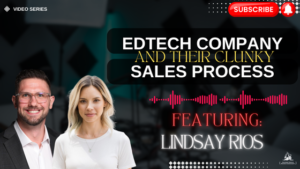Organizational Analysis Software Enterprise with Organizational Issues
Organizational Analysis Software Enterprise with Organizational Issues
- B2B marketing
- B2B SaaS marketing
- business growth tips
- content marketing
- demand generation
- digital advertising
- digital marketing strategies
- inbound marketing
- lead generation vs demand generation
- marketing and sales alignment
- marketing budget optimization
- marketing for startups
- organizational analysis
- revenue growth strategies
- SEO strategies

Dilara Cossette is the founder of Focus Image Pro, a demand generation agency specializing in B2B SaaS companies. She holds an MBA in marketing and has obtained certificates in various marketing specialties. With nearly a decade of experience in the marketing field, Dilara has developed a strong expertise in bridging the gap between marketing and sales teams, emphasizing the importance of collaboration and alignment towards common goals. Her approach centers around creating effective demand generation strategies that go beyond traditional lead generation, focusing on organic methods like social selling and brand awareness. She is known for her strategic mindset, often working closely with finance teams and stakeholders to ensure that marketing efforts are revenue-oriented and aligned with broader business objectives.
This exciting conversation is hosted by Matt Wilhelmi, owner of Strategic Voyages Business Consultants and author of “Taboo Business Questions: What’s Haunting Every Entrepreneur’s Growth.”
Dilara Cossette and Matt Wilhelmi – Episode 1
In the first episode, Dilara Cossette discusses a case study with Dilara Cossette with Matt Wilhelmi, organizational development consultant. The case revolves around a B2B SaaS company that provides organizational analysis services to high-growth companies. This company faced three primary issues:
- Lack of Industry Awareness: The company struggled to educate the market about their niche software solution. Despite a significant marketing investment, there was limited awareness about their product among potential customers.
- Ineffective Marketing Spend: With an annual marketing budget exceeding $1 million, primarily on PPC and SEO, the company wasn’t generating a satisfactory number of new leads. Most of the leads were coming directly through the CEO’s network rather than from their broader marketing efforts.
- Stagnant Email List Growth: The company’s email newsletter subscriber count had plateaued, which was a concern as it is a key indicator of engagement and demand generation effectiveness.
To better understand these challenges, Dilara asked several clarifying questions during their conversation. She inquired about the company’s ideal customer profile (ICP), the size and geographical focus of their target market, the effectiveness of current marketing channels, and their existing sales and marketing processes. Dilara emphasized the importance of aligning marketing and sales teams, understanding the pain points of both, and ensuring clear communication to address the gaps in their demand generation strategy.
In the next episodes, Matt and Dilara plan to explore cautionary tales of companies mishandling demand generation and how organizational culture and employee engagement can influence these strategies.
Dilara Cossette and Matt Wilhelmi – Episode 2
Cautionary Tales and Lessons Learned 🚩📉
In this episode, Matt Wilhelmi and Dilara Cossette discuss three cautionary tales that highlight the challenges organizations face when managing demand generation and how it affects broader business dynamics. Here’s a summary of the three stories shared:
- Organizational Culture Conflicts: Dilara shares her experience working with organizations where a lack of alignment between marketing and sales teams led to conflicts during meetings. In some cases, these disagreements were so severe that they were vocal and visible during client calls. This toxic environment often stemmed from poor communication and a lack of shared goals, causing stress and inefficiency. Dilara emphasizes the importance of having both teams work together towards common objectives. By bridging the gap between marketing and sales, organizations can create a more cohesive culture, improve communication, and ultimately enhance demand generation outcomes.
- Lack of Diversification in Demand Generation Strategy: Matt recounts a story about a SaaS company that was overly focused on a single market segment: educational institutions. Despite opportunities to expand into other sectors, such as logistics and IT companies, the leadership was unwilling to diversify their approach. This narrow focus put the company at risk, especially if their primary market’s needs or regulations changed. Matt highlights the danger of being too narrowly focused and stresses the importance of testing new channels and diversifying marketing efforts to avoid stagnation and ensure continued growth.
- Employee Disengagement Due to Ineffective Strategies: Dilara discusses a case where employee disengagement became a significant issue because of ineffective demand generation strategies. Sales teams often felt unsupported and unheard, leading to frustration and lack of motivation. This was exacerbated when their suggestions or feedback were consistently ignored or rejected. Such disengagement directly impacted performance, resulting in a decline in sales and overall productivity. Dilara underlines the importance of listening to sales teams, fostering a culture of transparency and trust, and ensuring that all team members feel valued and heard. By doing so, organizations can maintain high engagement levels and improve their demand generation efforts.
These cautionary tales underscore the importance of effective communication, strategic diversification, and employee engagement in driving successful demand generation initiatives. The discussion sets the stage for the next episode, where Matt and Dilara will explore practical solutions to these challenges.
Dilara Cossette and Matt Wilhelmi – Episode 3
In this video, Matt Wilhelmi and Dilara Cossette discuss solutions to a case study involving a B2B SaaS company facing three major challenges in their demand generation efforts. Here’s a review of the issues and the solutions Dilara suggests:
Case Study Review:
- Lack of Industry Awareness: The company struggled with low visibility in their industry, which impacted their ability to attract new clients and generate demand.
- Ineffective Social Media Marketing: Despite significant investment in social media marketing, both PPC and organic SEO efforts were not yielding sufficient leads. Most of the leads were coming from the CEO’s personal network rather than the marketing campaigns.
- Stagnant Email List Growth: The company’s email list was not expanding or generating new leads, limiting their ability to nurture potential clients and engage with their audience effectively.
Solutions Discussed:
- Increase Brand Awareness through Brand Advocacy and Ambassadorship:
- Dilara suggests leveraging brand advocacy and ambassadorship as cost-effective ways to boost brand awareness without relying solely on paid advertising. This involves utilizing the CEO’s and other leaders’ personal social media accounts to share stories, experiences, and expertise.
- She explains that social media posts from personal profiles tend to receive significantly higher engagement than those from company pages. This strategy builds trust and credibility, as people are more inclined to connect with and trust individuals rather than faceless organizations. Dilara also recommends identifying brand ambassadors—either internal employees or external influencers—who can share authentic stories and promote the company’s solutions more organically.
- Reallocate Social Media Budget to Boost Organic Posts:
- To address the ineffective social media marketing, Dilara recommends redistributing the social media budget. Instead of spending heavily on PPC campaigns, the company should consider boosting organic posts from personal profiles or brand ambassadors. This strategy could lead to higher engagement and conversion rates, as people trust recommendations coming from individuals they follow or admire.
- She also suggests exploring LinkedIn’s feature that allows companies to boost posts not only from their employees but also from people not directly affiliated with the company. This could involve collaborations with industry influencers or experts who have a substantial following and can effectively advocate for the brand.
- Enhance Email Marketing Strategies and Partnerships:
- For the stagnant email list issue, Dilara emphasizes the importance of first evaluating and optimizing the existing lead nurturing sequences and segmentation strategies before attempting to grow the list. Understanding how current leads are engaged and segmented is crucial to ensure that the right content is being sent to the right audience.
- Once the internal processes are optimized, she suggests expanding the list through strategic partnerships. Collaborating with external vendors, influencers, or media outlets to co-create content such as articles, webinars, or joint email campaigns can help drive traffic and encourage new subscriptions. Additionally, leveraging pop-ups and other website tools can help convert traffic into email subscribers more effectively.
Conclusion:
Dilara’s strategies provide a holistic approach to improving the company’s demand generation efforts. By focusing on authentic, personal engagement, reallocating resources more effectively, and optimizing internal processes before expansion, companies can better position themselves for sustainable growth. These solutions underscore the importance of strategic thinking and adaptability in overcoming common marketing challenges faced by many B2B SaaS companies.
Matt concludes the video by highlighting Dilara’s expertise and comprehensive approach, emphasizing the value of her insights for companies looking to refine their demand generation strategies.





